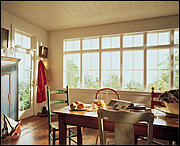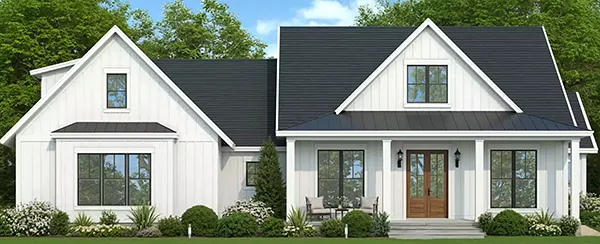Choosing the Right Glass
 While clear glass has always been the primary material available for windowpanes in homes that is starting to change as homeowners are looking for a new "green" view. Now windows are being glazed- to cut and fit window panes into frames - in a whole new way to help control heat loss, condensation and enhance the design of your home's face. You can get double-glaze windows, which have two layers of glass separated with a space to help trap air and provide some insulation value or triple-glazed which have three layers of glass or two layers with a low-e layer between the two. If you live in an area where weather is extremely hot or cold, triple protection is the best, but they're much heavier and more difficult to operate.
While clear glass has always been the primary material available for windowpanes in homes that is starting to change as homeowners are looking for a new "green" view. Now windows are being glazed- to cut and fit window panes into frames - in a whole new way to help control heat loss, condensation and enhance the design of your home's face. You can get double-glaze windows, which have two layers of glass separated with a space to help trap air and provide some insulation value or triple-glazed which have three layers of glass or two layers with a low-e layer between the two. If you live in an area where weather is extremely hot or cold, triple protection is the best, but they're much heavier and more difficult to operate.
Low-E ("low emissivity") window glass
Low E window glass is treated with a layer of invisible, microscopic silver coating to provide greater energy efficiency and increased comfort. Low E stands for "low emissivity", which is the action of reflecting light passing through glass. The benefits of low-e are they reduce the U-Value (conductance of heat) increase the R-Value (resistance to heat flow), making for a more comfortable environment. It also helps cut back on harmful UV rays (by 78%) that over time will fade your rugs and furniture.
Specialty glass options
Today most reputable glass manufacturers offer interesting combinations of window glass options to protect you from the sun and neighborhood noise to help you build a safe and private home.
You can get your glass obscured in a variety of colors and texture patterns to create a translucent to semi-opaque look or tinted to provide additional shading (tones include bronze, gray, evergreen and azurite - names vary from manufacturer). Other options to consider are high performance glass like tempered, which is the Hercules of glass. Not only is it extra strong, but also if it breaks, it won't shatter into a zillion sharp edges, but rather a zillion pebble-like pieces. If you don't want to be affected by excessive outdoor noise, then you might want to consider laminated glass, which is very effective in reducing noise. It also eliminates 99.9% of UV (ultraviolet) rays.
Types of Frame Materials
Window frames are available in a variety of materials including aluminum, wood, vinyl, fibrex, and fiberglass. Frames may be primarily composed of one material, or they may be a combination of different materials such as wood and vinyl and each frame material has its advantages and disadvantages.
Aluminum is ideal for customized window design, however, aluminum frames cause conductive heat loss (i.e., they have low R-values) and condensation. By inserting thermal breaks made of insulating plastic strips between the inside and outside of the frame and sash you can greatly improve the thermal resistance of aluminum frames.
The benefits of wood is it produces higher R-values, are unaffected by temperature extremes, and are less prone to condensation, but they do require some maintenance - like periodic painting. A note of caution: if wood frames are not properly protected from moisture, they can warp, crack, and stick.
Vinyl windows are made primarily from polyvinyl chloride (PVC), which offers many advantages, like a large selection of styles and shapes, moderate to high R-values, easily customized, competitively priced, require low maintenance, and mold easily into almost any shape.
Fiberglass have the highest R-values of all frames and are excellent for insulating and will not warp, shrink, swell, rot, or corrode. Fiberglass frames can be made in a variety of colors and can hold large expanses of glass. Some fiberglass frames are hollow and others are filled with fiberglass insulation.
Bottom line, if you want to save money heating your house in winter and cooling it in summer, take a close look at the glass in your windows.



.png)
.png)
 While clear glass has always been the primary material available for windowpanes in homes that is starting to change as homeowners are looking for a new "green" view. Now windows are being glazed- to cut and fit window panes into frames - in a whole new way to help control heat loss, condensation and enhance the design of your home's face. You can get double-glaze windows, which have two layers of glass separated with a space to help trap air and provide some insulation value or triple-glazed which have three layers of glass or two layers with a low-e layer between the two. If you live in an area where weather is extremely hot or cold, triple protection is the best, but they're much heavier and more difficult to operate.
While clear glass has always been the primary material available for windowpanes in homes that is starting to change as homeowners are looking for a new "green" view. Now windows are being glazed- to cut and fit window panes into frames - in a whole new way to help control heat loss, condensation and enhance the design of your home's face. You can get double-glaze windows, which have two layers of glass separated with a space to help trap air and provide some insulation value or triple-glazed which have three layers of glass or two layers with a low-e layer between the two. If you live in an area where weather is extremely hot or cold, triple protection is the best, but they're much heavier and more difficult to operate. 
